
At first I was admittedly hesitant to try salmon skin rolls. However, when I did give them a try, I was surprised by the salty seafood flavor and crispy texture that salmon skin rolls bring. If you’re looking for a unique roll with a fantastic flavor and crunchy texture, salmon skin rolls are worth a try.

Table of Contents
What are Salmon Skin Rolls?
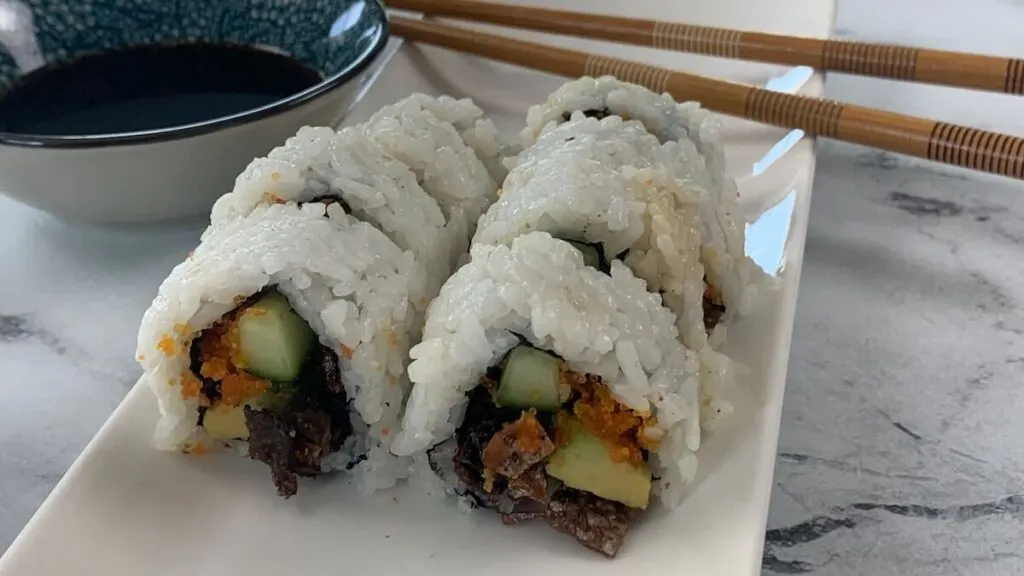
Salmon skin rolls are made with broiled salmon skins, vegetables, and sushi rice wrapped in a seaweed wrapper called a nori sheet. In addition, I also like to add some tobiko or masago to my rolls to add to the crispy texture and salty, seafood flavor provided by the salmon skins.
As with most sushi, the exact ingredients and presentation vary from cook to cook. I enjoy my salmon skin rolls prepared as an uramaki roll (rice on the outside of the nori sheet and fillings on the inside) with salmon skins, masago (or tobiko), cucumber, and avocado. However, I have seen these prepared with a crab or salmon filling on the inside with the salmon skins sprinkled over the top of the roll as well.
How to Control the Thickness of your Sushi Roll
You can control how thick your sushi rolls are by how much of the nori sheet you use. I prefer to use 1/2 to 3/4 of the nori sheet for salmon skin rolls. This makes the roll smaller and easier to eat with chopsticks.
If you like thicker rolls you can use the entire nori sheet. This would be easier to roll but would make it more difficult to eat with chopsticks.
How to Make Salmon Skin Rolls
While you can order salmon skins online, I usually peel the skins from the fillets whenever I cook or smoke salmon. I then freeze the salmon skins until I plan to use them. As long as salmon skins are kept in an airtight freezer bag or container, they should last up to three months in the freezer. Put them in the fridge to thaw the night before you plan on making salmon skin rolls and you will be good to go.
All the other ingredients can be easily found in most grocery stores. Check out the step-by-step instructions below:
Cook Sushi Rice
1. Rinse 1 1/3 cups of sushi rice by placing it in a colander and running water through it until the water is clear.
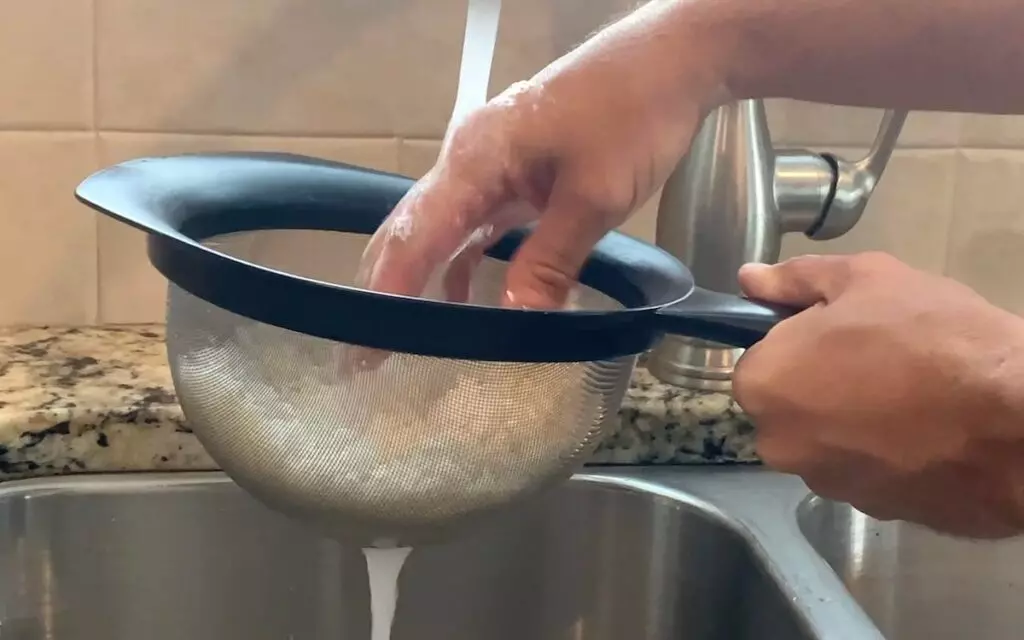
2. After the rice is rinsed, add it to a sauce pan with 1 2/3 cups of water (I would check the instructions on the sushi rice package to see exactly how much water to add as it can vary depending on the brand).

3. Bring the water to a boil and then reduce the heat to low. Cover and let the rice simmer for 20 to 30 minutes, or until the water is absorbed and the rice is soft.
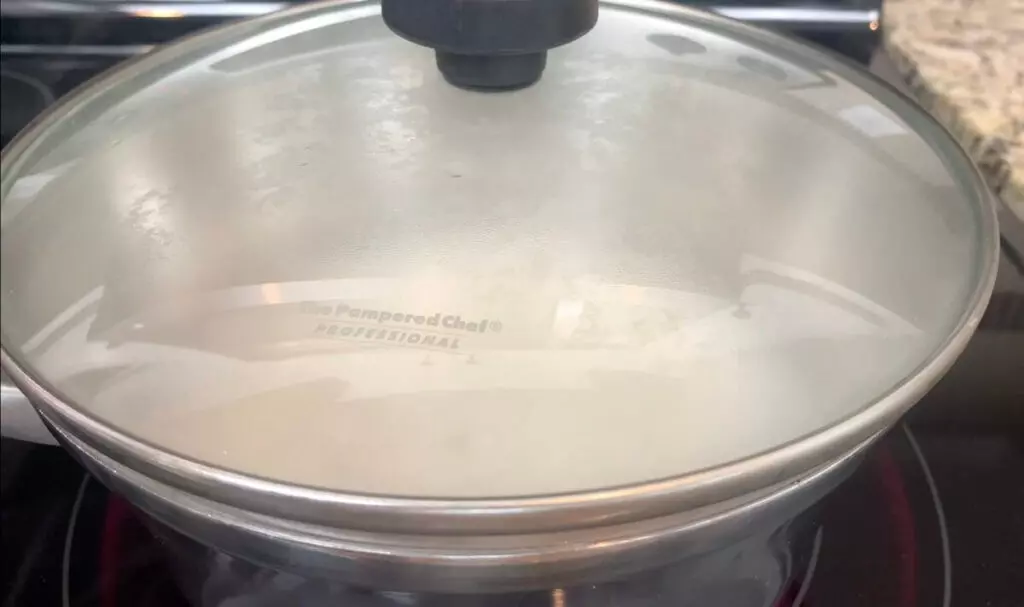
4. Remove the rice and place into a bowl or dish and let cool. I would line the dish with parchment paper prior to adding the rice to avoid it sticking.

5. Mix 1/4 cup of sushi vinegar into your rice. Stir until it has absorbed into the rice. Once cooled and the sushi vinegar is fully absorbed, your rice is ready to roll!

Prepare the Salmon Skin
1. Peel the salmon skin from the salmon fillet after cooking or smoking your salmon. This should peel off relatively easy if cooked thoroughly. I typically save my salmon skins in the freezer after eating a salmon meal and thaw in the fridge the night before I intend to make salmon skin rolls.
2. Turn your oven onto broil at high heat.
3. Cover a baking sheet with aluminum foil and spray with cooking spray.
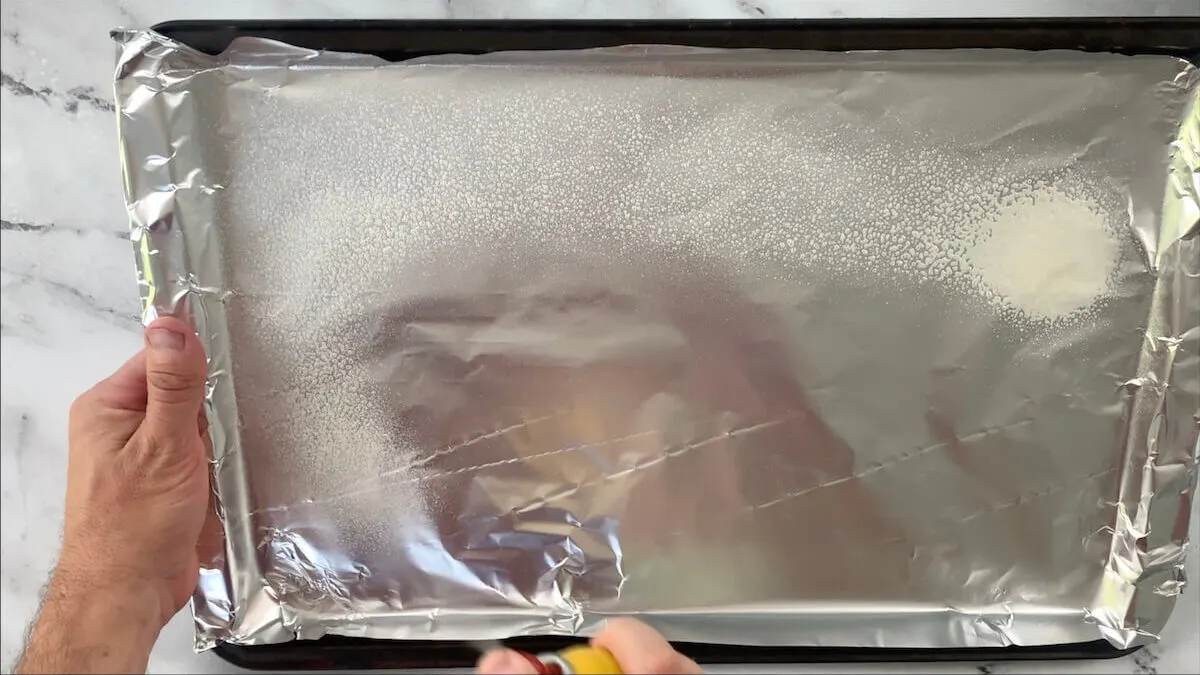
4. Add thawed salmon skins to the baking sheet and sprinkle with salt.
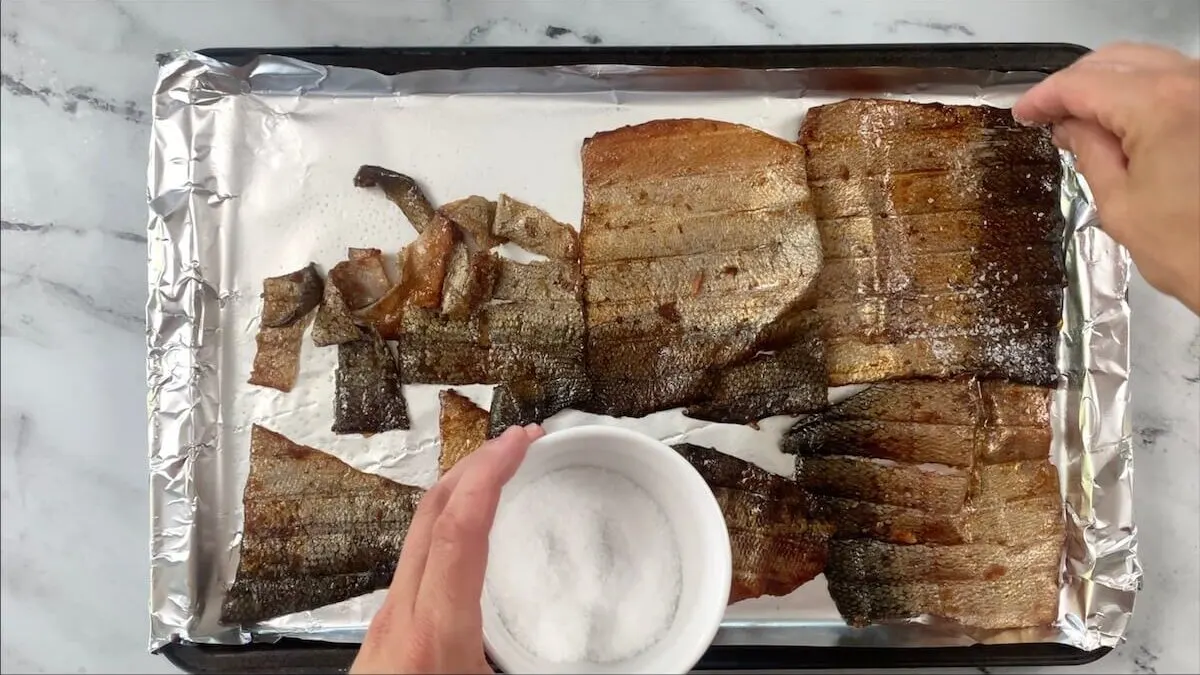
5. Broil the salmon skins on high heat for three minutes.
6. Once done broiling, dice the salmon skins into small pieces and place aside until needed in the roll.
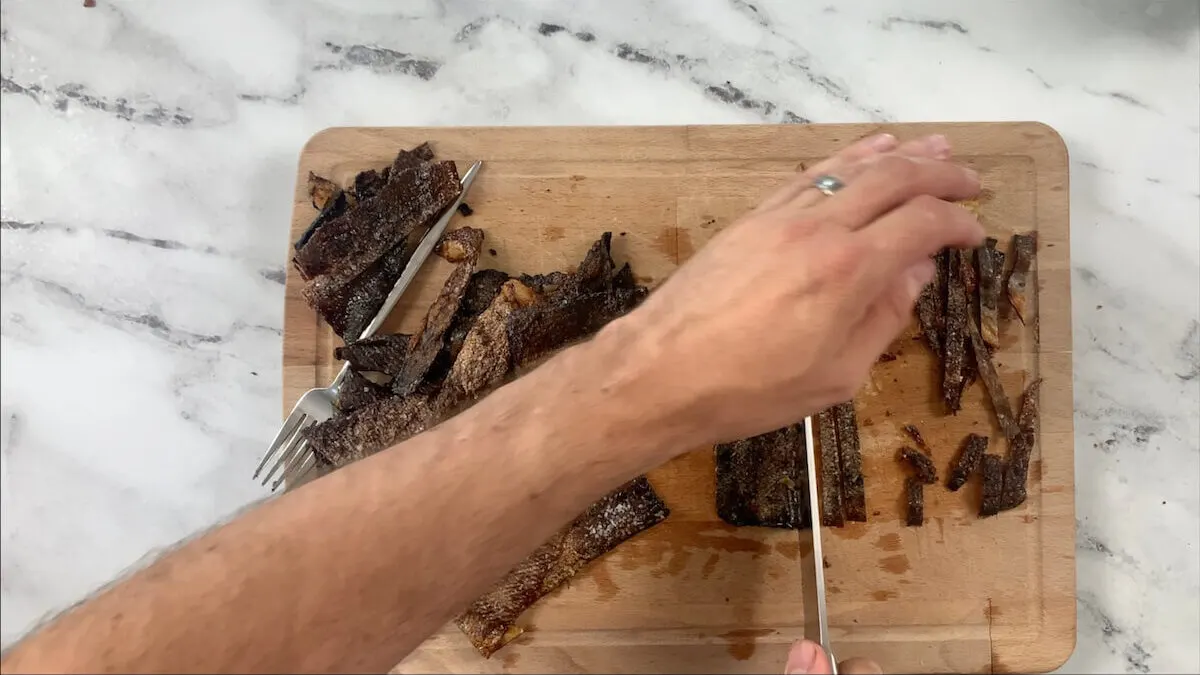
Assemble the Salmon Skin Rolls
1. Cover your bamboo sushi mat with plastic wrap. This will help keep the rice from sticking to it.
2. Use kitchen shears to cut the top fourth or so from the nori sheet. This helps to keep the rolls smaller and easier to eat with chopsticks.
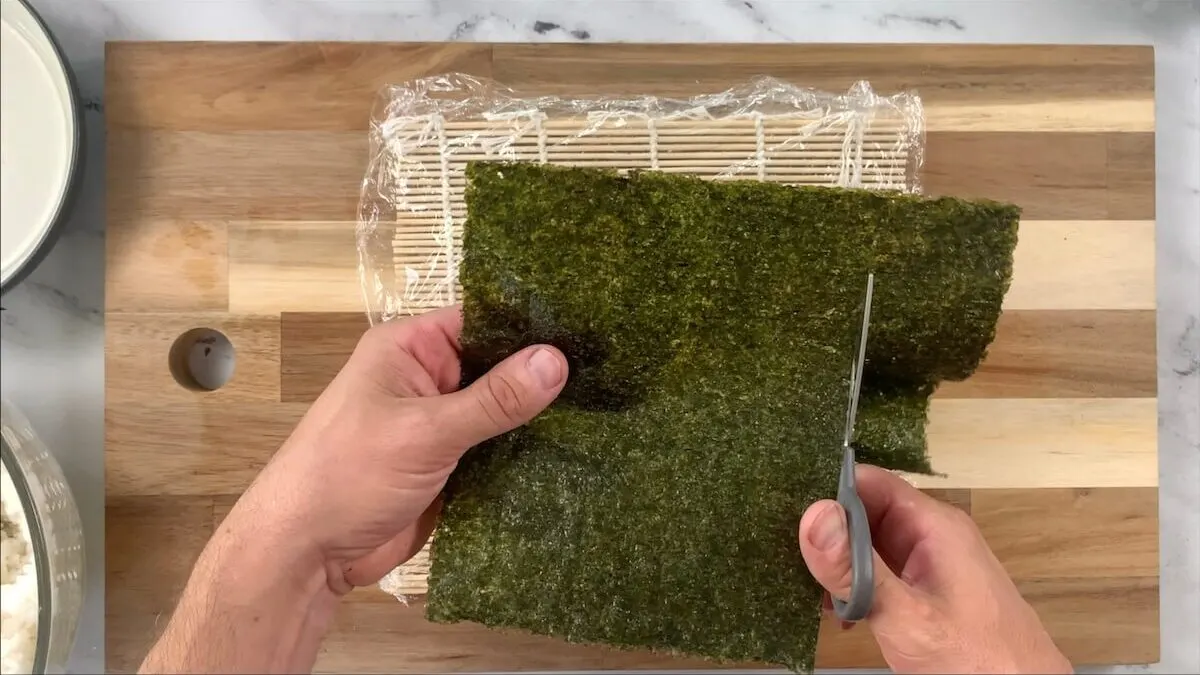
3. Next, place the nori sheet onto the plastic wrap with the shiny side facing down. Then press around 3/4 cup of rice onto the nori sheet in an even layer. Tip: Wet your hands in a bowl of water mixed with a splash of rice vinegar prior to handling the sushi rice. This will prevent the rice from sticking to your hands.
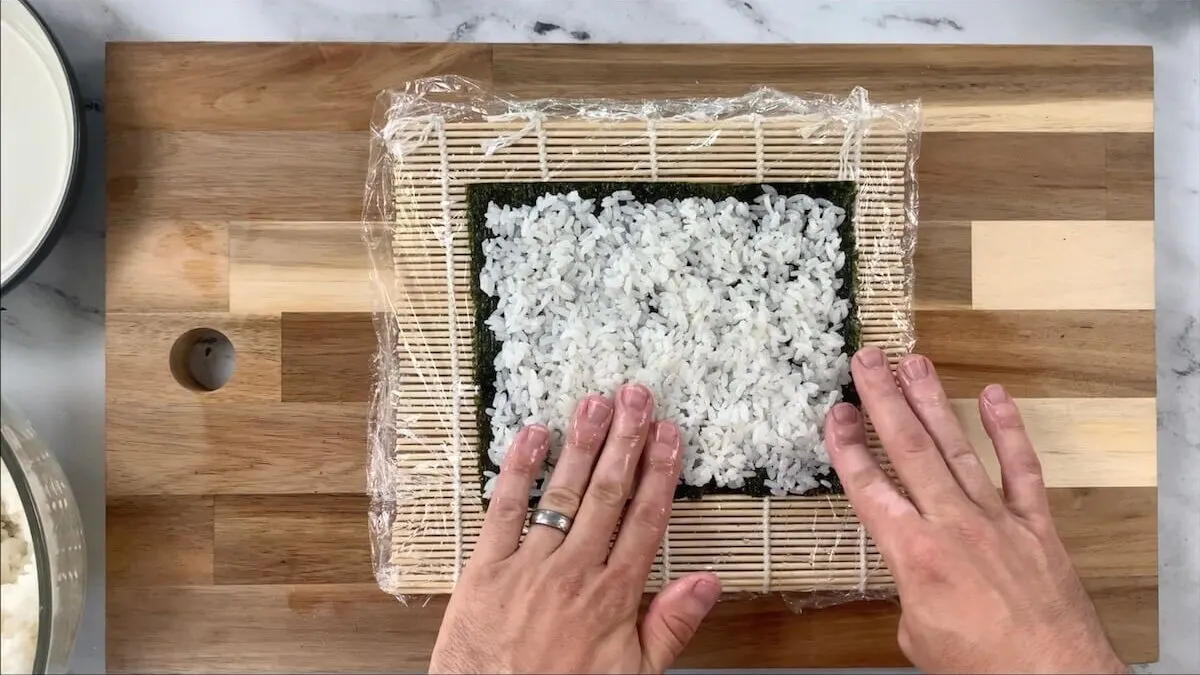
4. Flip the sheet over so the rice is facing down.
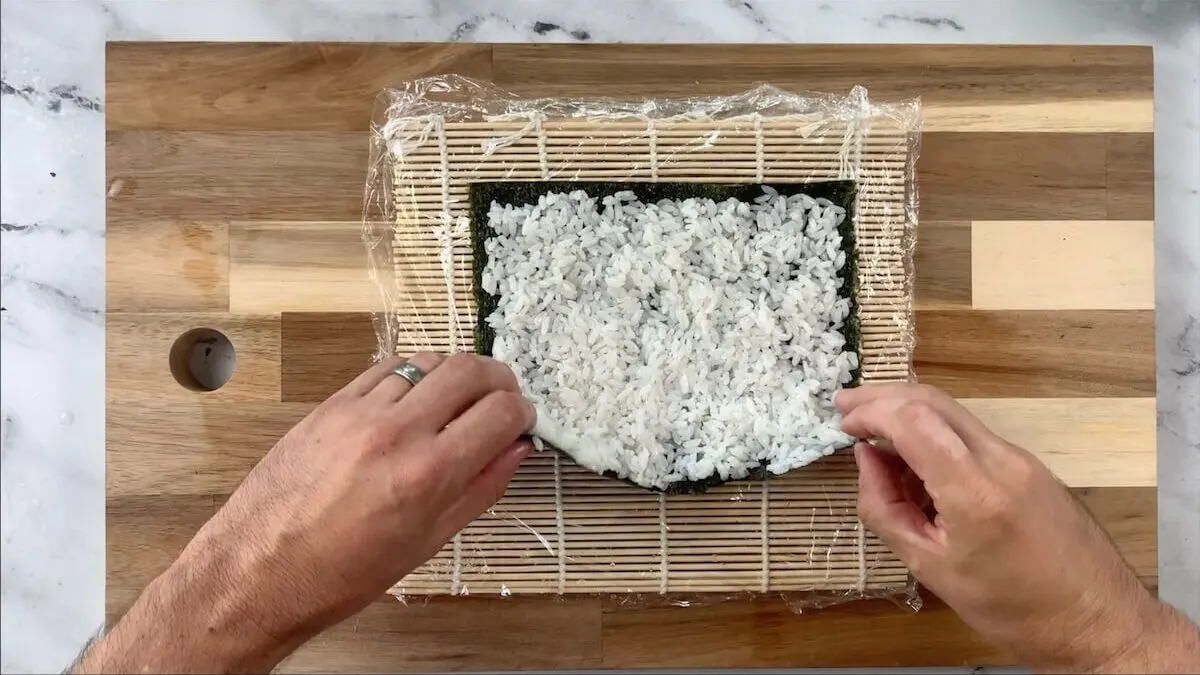
5. Add around a tablespoon of tobiko or masago in a row across the nori sheet. This will give the filling some color along with some additional flavor.
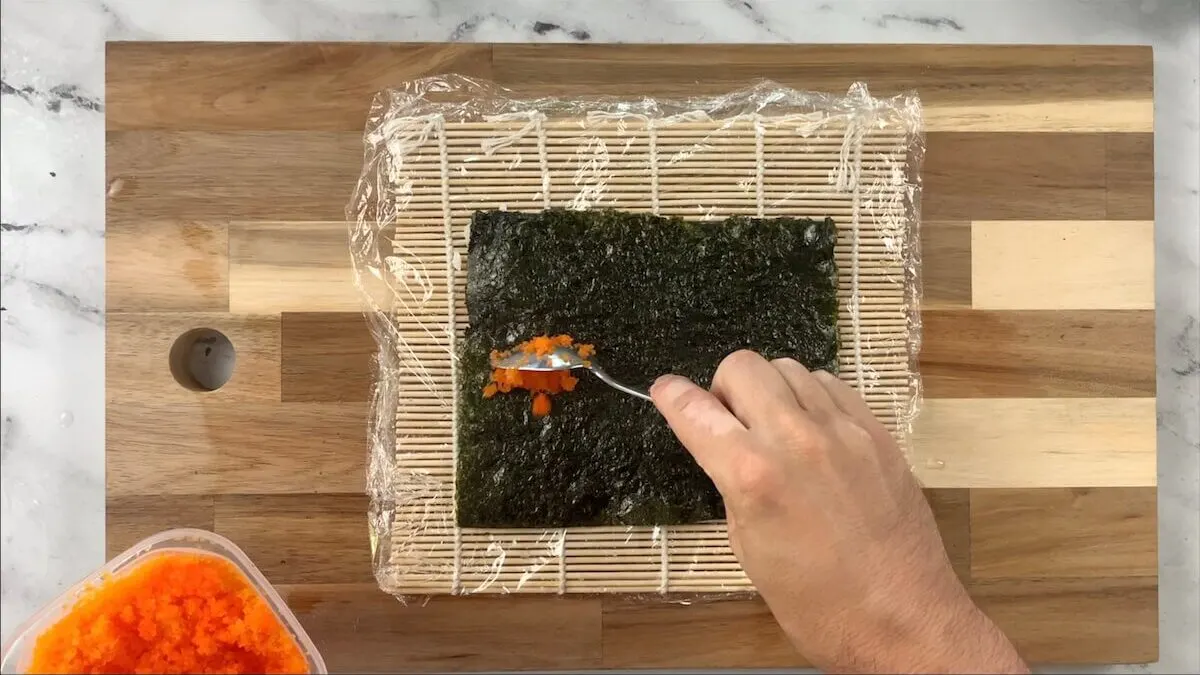
6. Slice the cucumbers into strips that are as long as your nori sheet and about 1/8 inch thick.
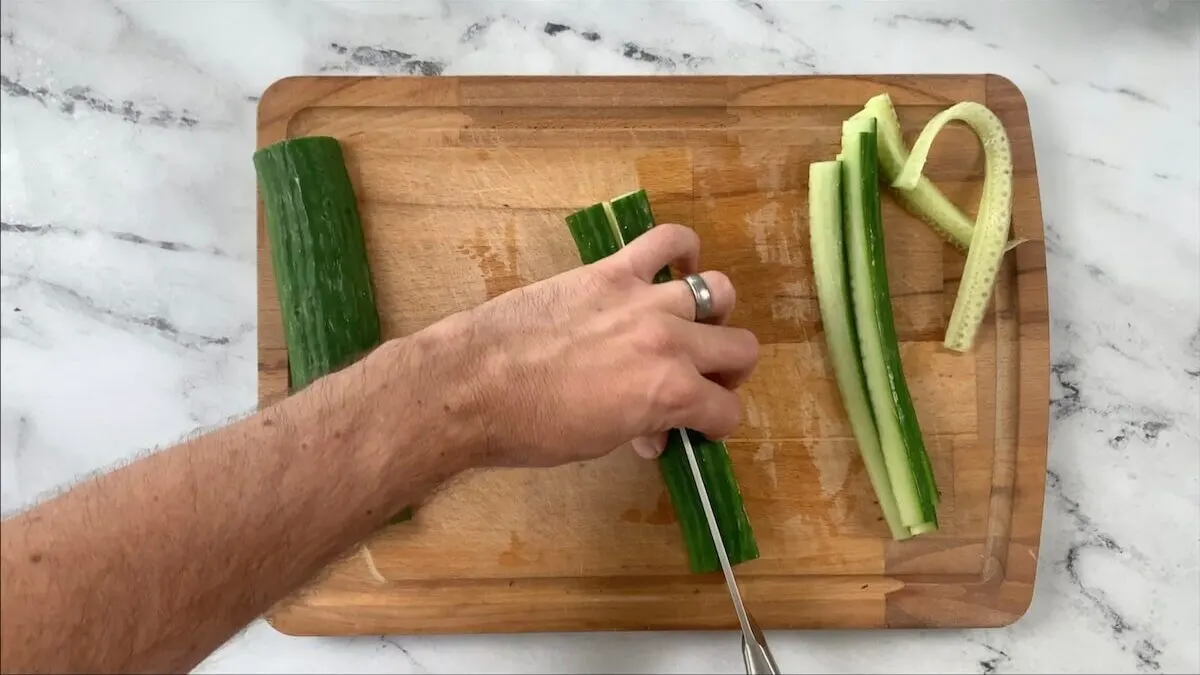
7. Slice the avocado in half the long way. Remove the seed and cut each half into 6 slices. Each whole avocado should yield around 12 slices. I often cut the slices right out of the avocado half and add directly to the roll to ensure freshness. You can also drizzle a little lemon juice over your cut avocado to prevent it from browning in your roll.
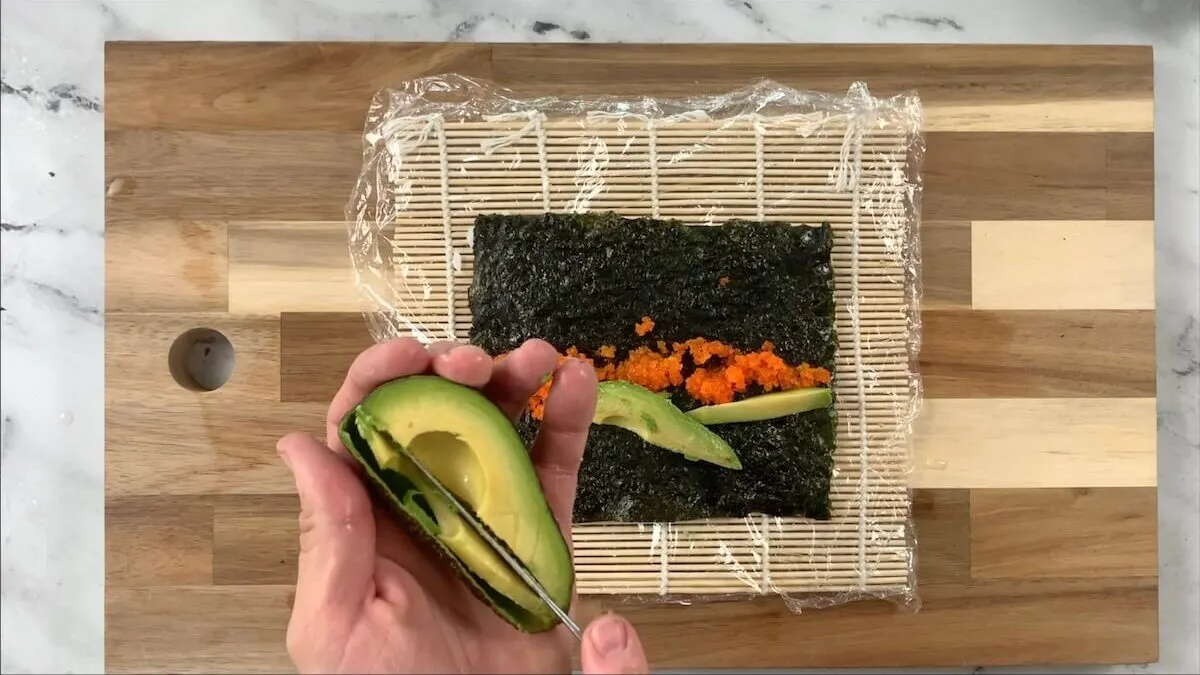
8. Add the cucumber sticks horizontally along the nori sheet. In general, I add 2-4 avocado slices and 1-2 cucumber sticks depending on the size of each ingredient and how everything fits.

9. Add around three tablespoons of the salmon skin pieces that you prepared in an even row across the sushi.
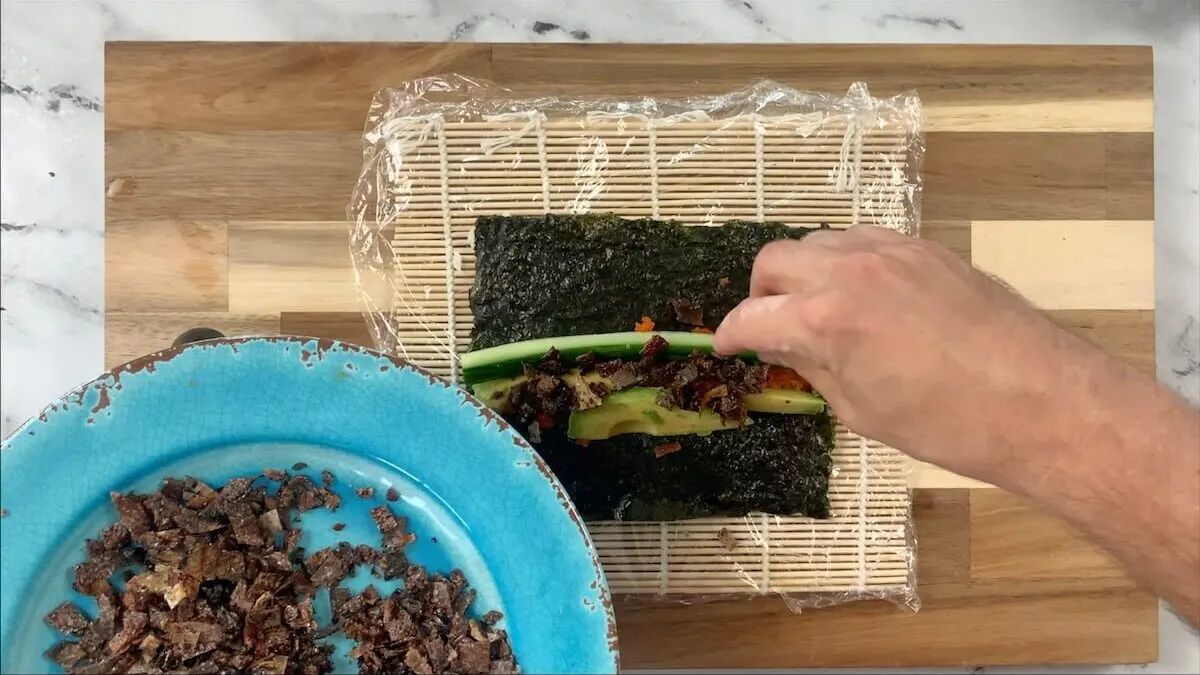
10. Use the bamboo sushi mat to fold your roll until it’s completely enclosed. Once the rice is making contact with the nori sheet, pull back the sushi mat so it doesn’t get caught in the roll. Still using the sushi mat as your guide, finish rolling until the roll is completely wrapped. Then wrap the sushi mat around the roll and gently tighten the roll together. Keep in mind that rolling sushi is an art that may take some practice so don’t get frustrated if it doesn’t look perfect your first time. It will get easier the more you do it. Tip: Check out the video for a demonstration on how to roll sushi.
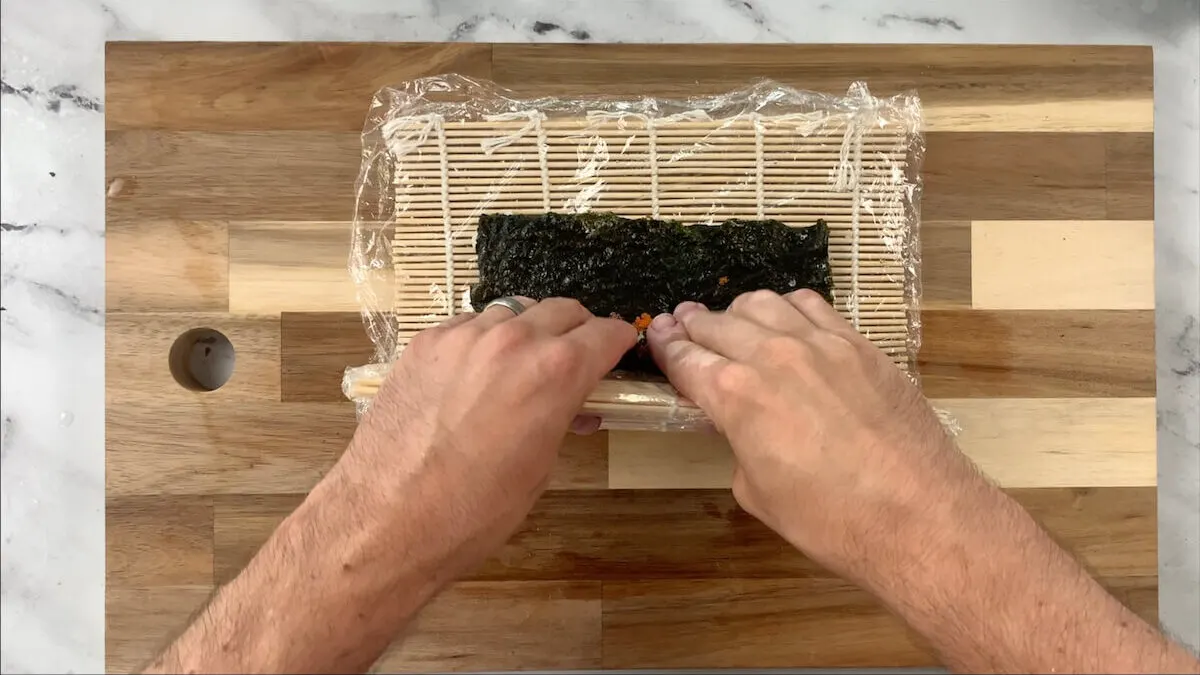
11. Using a sharp knife, cut the roll into 8 pieces. I do this by first cutting the roll in half. I then cut each half in half followed by cutting each fourth in half. Tip: Be sure to clean and wet the edge of your knife before cutting each roll.
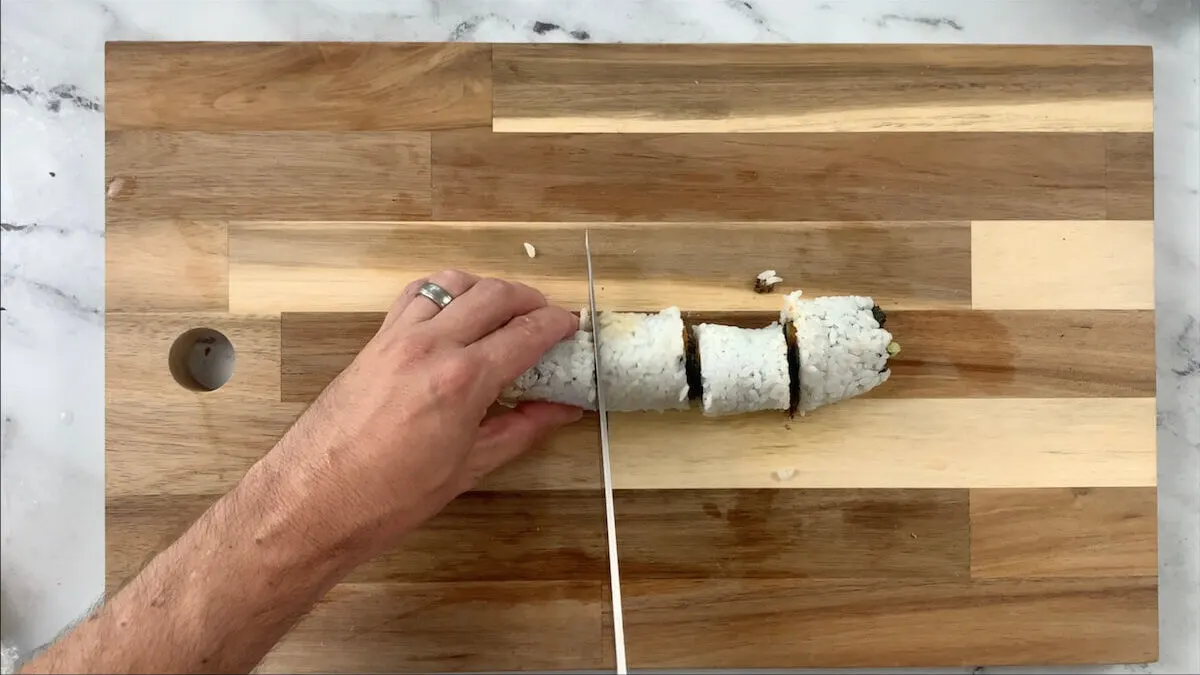
12. Serve and enjoy! You can serve with soy sauce, wasabi, and ginger. Eel sauce (unagi sauce) also goes well with these rolls.
Salmon Skin Roll Recipe

Salmon Skin Roll Recipe
Equipment
- 1 Bamboo Sushi Mat
- 1 Pot for cooking sushi rice
- 1 Sharp knife and cutting board
- 1 Baking sheet
Ingredients
Sushi Rice
- 1 1/3 cups Sushi Rice dried, will cook to 4 cups
- 1/4 cup Sushi Vinegar
Roll and Filling
- Salmon skin from 4 cooked or smoked 8 oz. salmon fillets
- 4 Nori Sheets
- 1 Ripe Avocado
- 1 English Cucumber Sliced into 1/8 sticks
- 1/4 Cup Masago or tobikio
- Salt
Instructions
Cook Sushi Rice
- Rinse 1 1/3 cups of sushi rice by placing it in a colander and running water through it until the water is clear.
- After the rice is rinsed, add it to a sauce pan with 1 1/2 cups of water (I would check the instructions on the sushi rice package to see exactly how much water to add as it can vary depending on the brand).
- Bring the water to a boil and then reduce the heat to low. Cover and let the rice simmer for 20 to 30 minutes, or until the water is absorbed and the rice is soft.
- Remove the rice and place into a bowl or dish and let cool. I would line the dish with parchment paper prior to adding the rice to avoid it sticking to the bowl.
- Mix 1/4 cup of sushi vinegar into your rice. Stir until it has absorbed into the rice. Once cooled and the sushi vinegar is fully absorbed, your rice is ready to roll!
Prepare the Salmon Skin
- Peel the salmon skin from the salmon fillet after cooking or smoking salmon. This should peel off relatively easy if cooked thoroughly. I typically save my salmon skins in the freezer after eating a salmon meal and thaw in the fridge the night before I intend to make salmon skin rolls.
- Turn your oven onto broil at high heat.
- Cover a baking sheet with aluminum foil and spray with cooking spray.
- Add thawed salmon skins to the baking sheet and sprinkle with salt.
- Broil the salmon skins on high heat for three minutes.
- Once done broiling, dice into small pieces and place aside until needed in the roll.
Assemble the Salmon Skin Rolls
- Cover your bamboo sushi mat with plastic wrap. This will help keep the rice from sticking to it.
- Use kitchen shears to cut the top fourth or so from the nori sheet. This helps to keep the rolls smaller and easier to eat with chopsticks.
- Next, place the nori sheet onto the plastic wrap with the shiny side facing down. Then press around 3/4 cup of rice onto the nori sheet in an even layer. Tip: Wet your hands in a bowl of water mixed with a splash of rice vinegar prior to handling the sushi rice. This will prevent the rice from sticking to your hands.
- Flip the sheet over so the rice is facing down.
- Add around a tablespoon of tobiko or masago in a row across the nori sheet. This will give the filling some color along with some additional flavor.
- Slice the cucumbers into strips that are as long as your nori sheet and about 1/8 inch thick.
- Slice the avocado in half the long way. Remove the seed and cut each half into 6 slices. Each whole avocado should yield around 12 slices. I often cut the slices right out of the avocado half and add directly to the roll to ensure freshness. You can also drizzle a little lemon juice over your cut avocado to prevent it from browning in your roll.
- Add the cucumber sticks horizontally along the nori sheet. In general, I add 2-4 avocado slices and 1-2 cucumber sticks depending on the size of each ingredient and how everything fits.
- Add around three tablespoons of the salmon skin pieces that you prepared in an even row across the sushi.
- Use the bamboo sushi mat to fold your roll until it is completely enclosed. Once the rice is making contact with the nori sheet, pull back the sushi mat so it doesn't get caught in the roll. Still using the sushi mat as your guide, finish rolling until the roll is completely wrapped. Then wrap the sushi mat around the roll and gently tighten the roll together. Keep in mind that rolling sushi is an art that may take some practice so don’t get frustrated if it doesn’t look perfect your first time. It will get easier the more you do it. Tip: Check out the video for a demonstration on how to roll sushi.
- Using a sharp knife, cut the roll into 8 pieces. I do this by first cutting the roll in half. I then cut each half in half followed by cutting each fourth in half. Tip: Be sure to clean and wet the edge of your knife before cutting each roll.
- Serve and enjoy! You can serve with soy sauce, wasabi, and ginger. Eel sauce (unagi sauce) also goes well with these rolls.
Video
Notes
Nutrition
Frequently Asked Questions
Are salmon skin rolls gluten-free?
Yes! All ingredients in salmon skin rolls are naturally gluten-free. However, if ordering from a restaurant it’s always a good idea to check as there are many variations of this roll.
Are salmon skin rolls healthy?
Yes, salmon skins have a high concentration of omega-3 fatty acids along with other important vitamins and minerals. The vegetables and fish roe included in salmon skin rolls are also very healthy for you.
Final Thoughts on Salmon Skin Rolls
Salmon skin rolls are a unique sushi roll that provide a crunchy texture and salty seafood flavor. I hope that you enjoy this recipe as much as I do! Happy cooking!
For more fun sushi recipes, check out the below articles:
How to Make Tamago (Egg) Sushi
Also, subscribe to our YouTube Channel for some great videos!
